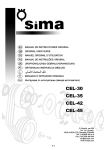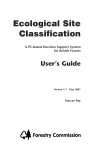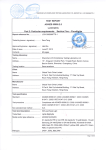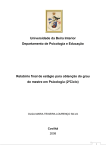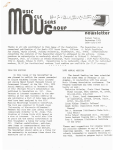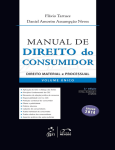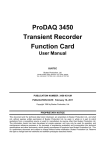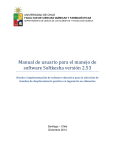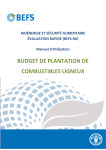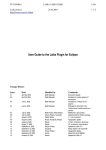Download English
Transcript
Viani & Rodrigues 772 POTENTIAL OF THE SEEDLING COMMUNITY OF A FOREST FRAGMENT FOR TROPICAL FOREST RESTORATION Ricardo Augusto Gorne Viani1; Ricardo Ribeiro Rodrigues2* 1 UNICAMP/Depto. de Botânica, Programa de Pós-Graduação em Biologia Vegetal, C.P. 6109 - 13083-970 Campinas, SP - Brasil. 2 USP/ESALQ - Depto. de Ciências Biológicas, C.P. 9 - 13418-900 - Piracicaba, SP - Brasil. *Corresponding author <[email protected]> ABSTRACT: Forest restoration projects are usually planted with a reduced number of species as compared to standing forests, largely due to the low availability of native species in seedling nurseries. In the present study, the potential of the native seedling community as a source of seedlings for forest restoration is analyzed. To do so, the seedling community from a forest fragment located in the southeast of Brazil was evaluated. Individuals (tree and shrub species) up to 30 cm height were measured and identified in 20 4 × 4 m plots. Altogether, 6,136 individuals (17 individuals m–2) belonging to 119 species were sampled. The seedling community showed a spatial heterogeneity with respect to the density of individuals and composition of species, and also a spatial aggregation for the 10 most abundant species. Several species that occurred in high densities in the seedling community are not presently available in regional forest nurseries and are therefore not used in restoration projects. This result and the high number of individuals and species found in the fragment suggest a great potential of this type of forest remnants as a source of highly diverse seedling banks for use in restoration projects. Key words: ecological restoration, natural regeneration, transplants, seedling production, forest nurseries POTENCIAL DA COMUNIDADE DE PLÂNTULAS DE UM FRAGMENTO FLORESTAL PARA A RESTAURAÇÃO DE FLORESTAS TROPICAIS RESUMO: Devido à baixa disponibilidade de mudas nos viveiros florestais, os projetos de restauração florestal são freqüentemente implantados com um número reduzido de espécies. Avaliou-se o potencial da comunidade de plântulas como fonte de mudas para a restauração florestal. Para tanto, a comunidade de plântulas de um remanescente florestal localizado no Sudeste do Brasil foi avaliada. Indivíduos arbustivos ou arbóreos com até 30 cm foram medidos e identificados em 20 parcelas de 4 × 4 m cada. Ao todo foram amostrados 6.136 indivíduos (17 indivíduos m–2), pertencentes a 119 espécies. A comunidade estudada apresentou heterogeneidade espacial em relação à densidade de indivíduos e a composição de espécies e agregação espacial para as 10 espécies mais abundantes. Várias espécies encontradas em alta densidade na comunidade de plântulas não estão disponíveis nos viveiros florestais regionais e, portanto, não são utilizadas em projetos de restauração. Esse resultado e a presença de um alto número de indivíduos e espécies no fragmento florestal sugerem um alto potencial desses tipos de remanescentes como bancos de plântulas com alta diversidade, disponíveis para uso em projetos de restauração. Palavras-chave: restauração ecológica, regeneração natural, transplantes, produção de mudas, viveiros florestais INTRODUCTION Seedlings of shrubs and trees play an important role in forest regeneration, as their survival and distribution affect the structure and maintenance of plant diversity in tropical and temperate forests (Harper, 1977; Denslow, 1991; Dalling et al., 1998). In tropical forests, the seedling community is composed of a large number of individuals and species which belong to different ecological groups (Hubbell et al., 1999; Oliveira et al., 2001; Grombone-Guaratini & Rodrigues, 2002; Comita et al., 2007). In spite of this observation, many Brazilian restoration projects do not fulfill the minimum richness and initial diversity in terms of species number and diversity of ecological groups, constraining the maintenance of a forest structure over the time and the reestablishment of ecological processes in these areas (Barbosa, et al., 2003; Souza & Batista, 2004). Sci. Agric. (Piracicaba, Braz.), v.66, n.6, p.772-779, November/December 2009 Seedling for forest restoration The limited number of seedling species used in restoration projects may be partly explained by the low availability of native species in seedling nurseries (Barbosa et al., 2003). This is the result of difficulties in obtaining seeds and the absence of technology to grow seedlings of many native species (Silva et al., 2003; Zamith & Scarano, 2004). In spite of this limitation, very few studies have investigated the potential of the native seedling community as a source of transplants to increase the plant diversity in ecological restoration, and these studies usually investigated only one or a few native species (Auer & Graça, 1995; Djers et al., 1998; Nemer et al., 2002). Here, the seedling community from a forest fragment in Southeastern Brazil was characterized. Based on the density of individuals, species richness and composition, we discuss the potential and management implications for using this community as a source of seedlings for nurseries and restoration projects. We expect to find a high number of individuals and species in the fragment and also many species that are not available in seedling nurseries, thus we hypothesized that this forest fragment can serve as an important source of seedlings for transplant to forest nurseries and restoration projects. MATERIAL AND METHODS This study was performed in Bofete, state of São Paulo, Southeastern Brazil (23º02’S, 48º11’W; 600 m elevation). The area consists of a 3,900 ha farm, of which 2,300 ha are designated to commercial plantation of Eucalyptus spp. and 650 ha are occupied by natural areas with native vegetation. The predominant climate, according to Köeppen’s classification, is the Cfa type, with average temperature > 22ºC on the hottest month (February) and < 18ºC on the coldest month (July). The annual rainfall is approximately 1,440 mm. The original vegetation is characterized as a seasonally dry forest belonging to the Atlantic Rainforest Biome (Veloso, 1992). However, the landscape has been highly fragmented to small and isolated pieces, usually restricted to places where the topography or the soil hinder agricultural development (Dinerstein et al., 1995; Di Bitetti et al., 2003). A single forest fragment of, approximately, 150 ha were chosen due to its similarity in disturbance history and vegetation type with other remnants found in the regional landscape. This fragment possesses areas with no fluvial influence and areas periodically flooded (swamp forest), both of which have evidence of historical disturbance. The sampling of the seedling community was performed between April and May 2003 by means of 20 ran- 773 domly installed 4 × 4 m plots (360 m2). Seedlings were defined as individuals from shrub or trees species up to 30 cm height, measured from the ground level up to the apical meristem. For individuals from the Arecaceae family, height was measured from the ground level up to the extremity of the tallest leaf, at its natural position. Within plots, all individuals that followed the inclusion criteria were measured and identified. Individuals that could not be identified in the field were collected for further identification in the ESA herbarium (Herbarium of the Dep. of Biology, University of São Paulo, Campus Luiz de Queiroz). Due to difficulties associated with the development stage that would not allow the precise morphological characterization of individuals, several individuals remained unidentified. All these individuals were grouped into a single group called “not identified”. Absolute frequency and relative densities were computed for each species, as described by Mueller-Dombois & Ellenberg (1974). The list of species sampled in the seedling community was compared to the list of 30 native species most commonly used in ecological restoration projects and also to the list of native wood species available in the 30 main seedling nurseries in the state of São Paulo (Barbosa et al., 2003). For comparison, the species sampled in the seedling community were classified into four classes; absent (0%), non-frequent (up to 25%), frequent (>25-50%) and highly-frequent (>50%), according to the frequency of availability in the nurseries evaluated by Barbosa et al. (2003). To better understand the management of natural regeneration for forest restoration projects, the spatial distribution (random, aggregated, or evenly spaced) of the seedling community (total number of individuals) and the ten most abundant species was tested. To do so, a Dispersion Index (observed variance / observed average) was calculated and its χ2 value was obtained as described by Ludwig & Reinolds (1988). χ2 values between Chi-square table critical values (p) of 0.975 and 0.025 indicate random distribution; higher probabilities (p > 0.975) suggest aggregated distribution and lower probabilities (p < 0.025) indicate uniform distribution. Morisita’s Standardized Index, which does not depend on the density of individuals in plots, was also measured (Krebs, 1989). Values vary from –1 to 1, with confidence limits from 0.5 to –0.5, where random patterns represent an index of 0, aggregated patterns above 0, and uniform patterns below 0. RESULTS AND DISCUSSION The seedling community and its potential for forest restoration In spite of the small sample size, we found a large Sci. Agric. (Piracicaba, Braz.), v.66, n.6, p.772-779, November/December 2009 774 Viani & Rodrigues number of species in the seedling community. Altogether, 6,136 individuals (17 individuals m–2) belonging to 119 species and 40 families were surveyed (Table 1). The most abundant families in decreasing order of number of species were Myrtaceae (20 species), Fabaceae (14), Rubiaceae (13) and Lauraceae (7). Altogether, these four families represented 45.4% of the total species sampled. The total number of species is similar to the values found in other tropical seedling communities (Oliveira et al., 2001; Grombone-Guaratini & Rodrigues, 2002). However, it is far more than the values commonly used in regional forest restoration projects, even those located in high diversity tropical regions (Parrotta & Knowles, 1999; Barbosa et al., 2003; Souza & Batista, 2004). The number of seedlings per plot varied between 74 and 1,116, suggesting a high spatial heterogeneity in the density of individuals. This high spatial heterogeneity was also verified for species composition, such that 33 species (27.7% of the total) were found in only one plot and 15 species (11.6% of the total) occurred in more than 50% of plots. Many species presented low frequencies, but high densities in the plots where they were sampled. For instance, Eugenia ligustrina (Myrtaceae) was sampled in only one plot, where it was the species present with the highest density (212 individuals). Spatial heterogeneity is present in other tropical seedling communities (Hubbell et al., 1999; Oliveira et al., 2001), suggesting that it is a characteristic of these communities. Nineteen species (16%) were sampled with only one individual. This can be attributed in part to the small sampling size, as well as to seasonality in recruitment (Lieberman, 1996), environmental heterogeneity, and absence of suitable sites for the recruitment of each specific species. However, several authors have shown that many tropical shrub and tree species are considered rare and occur in very low densities in the forest (Foster & Hubbell, 1990; Pitman et al., 1999; Kageyama & Gandara, 2004; Comita et al., 2007). Protium spruceanum (Burseraceae) was present at a very high density, comprising 56.7% of the total individuals. The prominent position of P. spruceanum is possibly due to the presence of a number of plots close to areas with flooded soil, where adult individuals from this species are also prevalent. This species is typical of swampy forests (Ivanauskas et al., 1997). Moreover, the sampling period coincided with the post-germination period of plants of the same species, in a year of exceptional seed production. Indeed, many tropical shrub and tree species possess supra-annual reproductive characteristics, with production of large cohorts at intervals greater than one year (De Steven, 1994; Lieberman, 1996; Connell & Green, 2000). Thus, besides the variation in the structure and composition of the seedling community across space (spatial variation), structure and composition also change in time (temporal variation) due to seasonality in the recruitment of individuals related to the phenological patterns of fruit maturation and seed dispersion (Santos & Válio, 2002), as well as due to the aforementioned supra-annual reproductive behavior of some species (Lieberman, 1996). Of the 95 identified species, 48.4% (46 species) are absent in the main nurseries in the state of São Paulo (Barbosa et al., 2003), 35.8% (34) are considered low-frequent (up to 25% of frequency), 7.4% (7) are frequent species (25-50% of frequency), and only 8.4% (8) are high-frequent species that occur in more than 50% of seedling nurseries in the state of São Paulo (Table 1). Only three species in the seedling community, Croton floribundus (Euphorbiaceae), Cedrela fissilis (Meliaceae) and Copaifera langsdorffii (Fabaceae), were included in the list of the 30 species most used in restoration projects in the state of São Paulo (Barbosa et al., 2003). Such data illustrate that the sampled seedling community is very different in terms of floristic composition as compared to the regional forest nurseries, and confirms that seedlings from several native species are not being produced. This is a striking result with respect to the potential of the seedling community as a source of seedlings for transplant into forest restoration projects. However, not all species sampled can be removed from the seedling community. Several species occur in very low density in the forest (Foster & Hubbell, 1990; Pitman et al., 1999; Kageyama & Gandara, 2004; Comita et al., 2007), and the removal of these seedlings, even for forest restoration purposes, is not recommended. Taking into account that the transplant of seedlings to restoration projects is restricted for only those species of high density, this analysis was performed again with only those identified species that had at least 20 sampled individuals. From 28 species, 16 (57.1%) are absent, seven (25%) are non-frequent and only two (7.14%) and three species (10.71%) are respectively frequent and high-frequent species in nurseries in the state of São Paulo (Barbosa et al., 2003). This serves as evidence that even species found in high densities in the seedling community are frequently absent in forest nurseries. The number of seedlings that belong to species with at least 20 individuals represents 91.7% (5,627 individuals) of the total community. Thus, although there are only 28 high density species, these species contain most of the individuals and also several species not found in the nurseries. Considering a hypothetical Sci. Agric. (Piracicaba, Braz.), v.66, n.6, p.772-779, November/December 2009 Seedling for forest restoration 775 Table 1 - Species sampled in the seedling community in a forest fragment, Bofete, São Paulo, Brazil; N: number of individuals. RD: relative density; NP: number of plots in which the species was sampled (maximum of 20); AF: absolute frequency; % Nurseries present: occurrence percentage in the 30 main native species nurseries in the state of São Paulo, Brazil according to Barbosa et al. (2003). F a mily Ana c a r d ia c e a e S p e c ie s A s t ro n iu m g r a v e o le n s J a c q . Ap o c yna c e a e Ar e c a c e a e NP AF % N ur s e r ie s p r e s e nt 37 1 0.02 1 5 1.25 16 80 20 G u a t t e r ia n ig re s c e n s M a r t. 2 0.03 1 5 0 A s p id o s p e r m a s u b in c a n u m M a r t. 2 0.03 2 10 10 Ta b e r n a e m o n t a n a h y s t r ix S te ud . 1 0.02 1 5 23 19 0.31 5 25 57 G e o n o m a b re v is p a t h a Ba r b . Ro d r. E u t e r p e e d u lis M a r t. 8 0.13 3 15 0 S y a g r u s ro m a n z o f f ia n a ( C ha m. ) Gla s s ma n 5 0.08 2 10 67 As t e r a c e a e G o c h n a t i a p o l y m o r p h a ( Le s s . ) C a b r e r a Bo r a gina c e a e C o rd ia s e llo w ia n a C ha m. Bur s e r a c e a e P ro t iu m s p r u c e a n u m ( Be nth. ) Engl. C e la s tr a c e a e RD 77 Ta p ir ir a g u ia n e n s is Aub l. Anno na c e a e N M a y t e n u s a q u if o lia M a r t. M a y t e n u s s a lic if o lia Re is s e k 19 0.31 7 35 40 5 0.08 3 15 17 3,482 56.74 12 60 0 2 0.03 1 5 3 238 3.88 12 60 0 C hlo r a ntha c e a e He d y o s m u m b r a s ilie n s e M iq . 6 0.10 2 10 0 C lus ia c e a e C a lo p h y llu m b r a s ilie n s e C a mb e s s . 17 0.28 5 25 43 C o mb r e ta c e a e Te r m in a lia t r if lo r a ( Gr is e b . ) Lillo 69 1.12 14 70 7 Eb e na c e a e Dio s p y ro s in c o n s t a n s J a c q . 2 0.03 2 10 3 Ela e o c a r p a c e a e S lo a n e a m o n o s p e r m a Ve ll. 15 0.24 6 30 0 Er ythr o xyla c e a e E r y t h ro x y lu m c u n e if o liu m ( M a r t. ) O . E. S c hulz Eup ho r b ia c e a e A c t in o s t e m o n c o m m u n is ( M üll. Ar g. ) P a x A lc h o r n e a t r ip lin e r v ia ( S p r e ng. ) M üll. Ar g. C ro t o n f lo r ib u n d u s S p r e ng. 7 0 . 11 2 10 0 33 0.54 7 35 0 6 0.10 4 20 17 132 2.15 7 35 60 M a p ro u n e a g u ia n e n s is Aub l. 13 0.21 3 15 0 P e r a g la b r a t a ( S c ho tt) P o e p p . e x Ba ill. 17 0.28 8 40 10 S e b a s t ia n ia c o m m e r s o n ia n a ( Ba ill. ) L. B. & Do wns 10 0.16 4 20 3 F a b . - c a e s a lp inio id e a e C o p a if e r a la n g s d o r f f ii De s f. 41 0.67 13 65 70 F a b . - c e r c id a e Ba u h in ia lo n g if o lia D. Die tr. 10 0.16 2 10 3 F a b . - mimo s o id e a e A lb iz ia p o ly c e p h a la ( Be nth. ) K illip e x Re c o r d 1 0.02 1 5 10 C a llia n d r a t w e e d ie i Be nth. 2 0.03 1 5 10 In g a m a rg in a t a Willd . 1 0.02 1 5 13 53 0.86 12 60 60 P ip t a d e n ia g o n o a c a n t h a ( M a r t. ) J . F. M a c b r. 9 0.15 3 15 37 A n d ir a f r a x in if o lia Be nth. 9 0.15 3 15 3 C e n t ro lo b iu m t o m e n t o s u m Guille min e x Be nth. 13 0.21 3 15 63 Da lb e rg ia f r u t e s c e n s ( Ve ll. ) Br itto n L o n c h o c a r p u s c u lt r a t u s ( Ve ll. ) AM G. Aze ve d o & HC . Lima M a c h a e r ium h ir t u m ( Ve ll. ) S te llfe ld 75 1.22 7 35 0 4 0.07 2 10 20 In g a v e r a Willd . F a b . - p a p ilio no id e a e M a c h a e r iu m b r a s ilie n s e Vo ge l M a c h a e r iu m s t ip it a t u m ( DC . ) vo ge l La c is te ma c e a e L a c is t e m a h a s s le r ia n u m C ho d a t 27 0.44 5 25 30 7 0 . 11 4 20 3 7 0 . 11 3 15 23 11 0.18 5 25 3 Continue... Sci. Agric. (Piracicaba, Braz.), v.66, n.6, p.772-779, November/December 2009 Viani & Rodrigues 776 Table 1 - Continuation. La ur a c e a e A n ib a f ir m u la ( N e e s & C . M a r t. ) M e z 3 0.05 2 10 0 E n d lic h e r ia p a n ic u la t a ( S p r e ng. ) J . F. M a c b r. 9 0.15 4 20 0 23 0.37 9 45 N e c t a n d r a c f. g r a n d if lo r a N e e s & C . M a r t. e x N e e s N e c t a n d r a o p p o s it if o lia N e e s & M a r t. - 1 0.02 1 5 Oc o t e a c f. v e lu t in a ( N e e s ) Ro hwe r 22 0.36 9 45 Oc o t e a c o r y m b o s a ( M e is n. ) M e z 16 0.26 7 35 0 1 0.02 1 5 3 P e r s e a p y r if o lia ( D. Do n) S p r e ng. 7 - Lythr a c e a e L a f o e n s ia p a c a r i A. S t. - Hil. 1 0.02 1 5 53 M e la s to ma ta c e a e L e a n d r a s c a b r a DC . 7 0.13 1 5 0 L ea n d ra sp . 1 0.02 1 5 M ic o n ia lig u s t ro id e s ( DC . ) N a ud in 1 0.02 1 5 M e lia c e a e M yr s ina c e a e M yr ta c e a e 0 Os s a e a s p . 1 0.02 1 5 Tib o u c h in a s e llo w ia n a C o gn. 7 0 . 11 4 20 0 C e d re la f is s ilis Ve ll. 5 0.08 3 15 93 - Tr ic h ilia c a t ig u a A. J us s . 14 0.23 4 20 0 Tr ic h ilia e le g a n s A. J us s . 3 0.05 3 15 0 47 0.77 15 75 0 7 0 . 11 2 10 0 Tr ic h ilia p a llid a S w. M o nimia c e a e - M o llin e d ia s c h o t t ia n a ( S p r e ng. ) P e r k ins Ra p a n e a c f. u m b e lla t a ( M a r t. ) M e z 79 1.29 18 90 - Ra p a n e a f e r r u g in e a ( Ruiz & P a v. ) M e z 30 0.49 10 50 33 C a m p o m a n e s ia c f. x a n t h o c a r p a O . Be r g. 5 0.08 4 20 - E u g e n ia c f. h y e m a lis C a mb e s s . 1 0.02 1 5 - E u g e n i a f l o r i d a DC . 1 0.02 1 5 7 212 3.45 2 10 0 E u g e n i a p l u r i f l o r a DC . 20 0.33 3 15 0 G o m id e s ia a f f in is ( C a mb e s s . ) D. Le gr a nd 37 0.60 8 40 3 M y rc ia b re v ir a m is ( O . Be r g. ) D. Le gr a nd . 5 0.08 3 15 0 E u g e n ia lig u s t r in a ( S w. ) Willd . M y rc ia c f. h a r t w e g ia n a ( O . Be r g. ) K ia e r s k . 5 0.08 2 10 M y rc ia f a lla x ( Ric h. ) DC . 90 1.47 14 70 3 M y rc ia g u ia n e n s is ( Aub l. ) DC . 37 0.60 11 55 0 M y rc ia m u lt if lo r a ( La m. ) DC . 25 0.41 4 20 3 M y rc ia r ia c f. t e n e lla ( DC . ) O . Be r g. 20 0.33 5 25 M y rc ia r ia f lo r ib u n d a ( H. We s t e x Willd . ) O . Be r g 9 0.15 6 30 - M yr ta c e a e s p . 1 1 0.02 1 5 - M yr ta c e a e s p . 2 1 0.02 1 5 - M yr ta c e a e s p . 3 1 0.02 1 5 - 0 M yr ta c e a e s p . 4 1 0.02 1 5 - M yr ta c e a e s p . 7 3 0.05 1 5 - M yr ta c e a e s p . 8 8 0.13 3 15 - M yr ta c e a e s p . 9 1 0.02 1 5 - S ip h o n e u g e n ia a ff. w id g re n ia n a O . Be r g. 17 0.28 9 45 N yc ta gina c e a e G u a p ir a h ir s u t a ( C ho is y) Lund e ll 26 0.42 9 45 P ip e r a c e a e Ot t o n ia c f. le p t o s t a c h y a K unth 0 18 0.29 1 5 P ip e r a r b o re u m Aub l. 2 0.03 1 5 0 P ip e r g a u d ic h a u d ia n u m K unth. 5 0.08 2 10 0 Continue... Sci. Agric. (Piracicaba, Braz.), v.66, n.6, p.772-779, November/December 2009 Seedling for forest restoration 777 Table 1 - Continuation. P o lygo na c e a e C o c c o lo b a c o rd a t a C ha m. 4 0.07 2 10 0 P r o te a c e a e Ro u p a la b r a s ilie n s is K lo tzs c h 43 0.70 5 25 3 Ro s a c e a e P r u n u s m y r t i f o l i a ( L. ) U r b . 15 0.24 6 30 13 Rub ia c e a e A m a io u a in t e r m e d ia M a r t. 4 0.07 2 10 3 C h o m e lia o b t u s a C ha m. & S c hltd l. 5 0.08 3 15 0 F a r a m e a m o n t e v id e n s is ( C ha m. & S c hltd l. ) DC . Ix o r a v e n u lo s a Be nth. P a lic o u re a m a rc g r a v ii A. S t. - Hil. P o s o q u e r ia s p . 15 0 2 10 0 197 3.21 15 75 2 0.03 1 5 - 1 0.02 1 5 3 0.05 2 10 0 0 5 0.08 4 20 63 1.03 13 65 0 Ra n d ia a r m a t a ( S w. ) DC . 2 0.03 1 5 0 Rub ia c e a e s p . 5 0.08 1 5 - Ba lf o u ro d e n d ro n r ie d e lia n u m ( Engl. ) Engl. 3 0.05 1 5 47 49 0.80 5 25 0 6 0.10 2 10 3 2 0.03 1 5 0 13 0.21 2 10 13 E s e n b e c k ia f e b r if u g a ( A. S t. - Hil. ) A. J us s . e x M a r t. E s e n b e c k ia g r a n d if lo r a M a r t. P ilo c a r p u s p a u c if lo r u s A. S t. - Hil. Z a n t h o x y lu m r h o if o liu m La m. S a p ind a c e a e 3 0.07 P s y c h o t r ia c f. c a r t h a g e n e n s is J a c q . P s y c h o t r ia s p . S a lic a c e a e 0.46 4 P s y c h o t r ia le io c a r p a C ha m. & S c hltd l. P s y c h o t r ia v e llo s ia n a Be nth. Ruta c e a e 28 - C a s e a r ia d e c a n d r a J a c q . 9 0.15 6 30 0 C a s e a r ia s y lv e s t r is S w. 2 0.03 2 10 20 8 0.13 4 20 10 C u p a n ia t e n u iv a lv is Ra d lk . A llo p h y lu s e d u lis ( A. S t. - Hil. , C a mb e s s . & A. J us s . ) Ra d lk . 63 1.03 13 65 0 M a t a y b a e la e a g n o id e s Ra d lk . 99 1.61 15 75 S a p o ta c e a e P o u t e r ia s p . 2 0.03 1 5 S ip a r una c e a e S i p a r u n a c u j a b a n a ( M a r t . ) A. DC . 1 0.02 1 5 40 0.65 2 10 S o la na c e a e C e s t r u m c f. s e n d t n e r ia n u m M a r t. 7 0 . 11 4 20 C e s t r u m s c h le c h t e n d a lii G. Do n. 4 0.07 1 5 0 St y r a x p o h li A. DC . 1 0.02 1 5 3 30 0.49 9 45 0 1 0.02 1 5 0 S ip a r u n a g u ia n e n s is Aub l. S tyxr a c e a e S ymp lo c a c e a e S y m p lo c o s t e n u if o lia Br a nd Vio la c e a e Hy b a n t h u s a t ro p u r p u re u s ( A. S t. - Hil. ) Ta ub Vo c hys ia c e a e Vo c h y s ia t u c a n o r u m M a r t. N o t id e ntifie d N o t id e ntifie d situation with 50% removal and transplant of the individuals from these species for forest restoration purposes, the sampled forest would provide approximately 2,814 seedlings for nurseries and/or restoration projects in a small area of 320 m2. Considering the arrangement of planted seedlings normally used in restoration projects in Brazil (one plant each 6 m2), such a number of seedlings is higher than the number needed to perform the restoration of 1 ha. Species not found in nurseries are also absent in restoration projects, which demonstrates the potential of the seedling community as a possible source of 8 0.13 3 15 120 1.96 19 95 3 0 0 - 0 - seedlings for forest restoration. Possibly, many species are not found in regional nurseries because of the lack of knowledge around the biology of these species with respect to flowering and fruiting, or because of the unavailability of specific technology to process and germinate seeds. In these cases, the transplant of forest seedlings to nurseries or directly to restoration areas emerges as a viable alternative until the knowledge required for the cultivation of seedlings of these species is obtained. Thus, the use of the seedling community and populations of some species as source of seedlings for ecological restoration is justifiable. For Sci. Agric. (Piracicaba, Braz.), v.66, n.6, p.772-779, November/December 2009 778 Viani & Rodrigues Table 2 - Patterns of spatial distribution of the seedling community in 4 × 4 m plots in a forest fragment in Bofete, São Paulo, Southeastern Brazil. All dispersion Index (DI) values presented a Chi-square probability level higher than 0.975. Morisita Standardized Index (Ip) between 0.5 and 1 (with confidence limit of 95%) indicate aggregated pattern. DI Ip S p a tia l d is tr ib utio n C o m m u n it y ( a ll s p e c ie s to ge the r ) S p e c ie s 317.95 0.52 a ggr e ga te d P ro t iu m s p r u c e a n u m ( Be nth. ) Engl. 638.73 0.59 a ggr e ga te d M a y t e n u s s a lic if o lia Re is s e k E u g e n ia lig u s t r in a ( S w. ) Willd . 57.12 0.62 a ggr e ga te d 209.90 1.00 a ggr e ga te d P a lic o u re a m a rc g r a v ii A. S t. - Hil. 30.43 0.57 a ggr e ga te d C ro t o n f lo r ib u n d u s S p r e ng. 31.98 0.61 a ggr e ga te d Da lb e rg ia f r u t e s c e n s ( Ve ll. ) Br itto n 20.60 0.63 a ggr e ga te d M a t a y b a e la e a g n o id e s Ra d lk . 12.60 0.55 a ggr e ga te d M y rc ia f a lla x ( Ric h. ) DC . 8.60 0.54 a ggr e ga te d Ra p a n e a c f. u m b e lla t a ( M a r t. ) M e z 6.33 0.53 a ggr e ga te d Ta p ir ir a g u ia n e n s is Aub l. 5.60 0.53 a ggr e ga te d instance, P. spruceanum, E. ligustrina and Maytenus salicifolia (Celastraceae) are not found in the main nurseries in the state of São Paulo, Brazil (Barbosa et al., 2003), but were sampled in the seedling community in high densities. These species are good examples of species that could be introduced into restoration projects by using seedlings available in the forest. For both calculated indexes, the whole species community and the ten most abundant species demonstrated aggregated spatial distribution (Table 2) at the 4 × 4 m sampling scale. The small-scale spatial aggregation in the initial life stage seems to be common and has already been observed in other tropical forests (Oliveira et al., 2001). Many species are not able to disperse their seeds efficiently, aggregating around parent individuals (Houle, 1992) or in the case of the pioneer species, under forest gaps that receive direct light (Grau, 2000). The spatial heterogeneity with respect to density and richness and the spatial aggregation found for the main species, demonstrate that the potential of the seedling community as a source of seedlings for forest restoration depends on the way the seedlings are collected in the forest fragment. Thereby, for the use of the seedling community as a source of transplants, a larger collecting area will yield a greater number of species. Besides spatial heterogeneity, temporal heterogeneity also affects the seedling community composition. Considering that seasonality of dispersion and recruitment is a common characteristic for tropical communities (Lieberman, 1996; Santos & Válio, 2002), the potential of seedling community in terms of richness of species would certainly be higher if the community was sampled and collected in more than one period of the year. The seedling community has high richness and density and contains several abundant species not found in forest nurseries and restoration projects. This confirms our initial hypothesis that forest fragments can serve as an important source of seedlings to be used in forest restoration projects. Although the data presented is regional, researchers that evaluated the seedling community in other tropical forests (Hubbell, 1999; Oliveira et al., 2001; Benitez-Malvido & LemusAlbor, 2005) have demonstrated similar results regarding richness and density of plants. This suggests that the high potential of the seedling community is probably not restricted to the case study presented here, but can be addressed to other similar remnants of tropical forest. The seedling community, as a source of seedlings for ecological restoration purposes, could be useful for many situations in the restoration of degraded areas such as restoration plantations, enrichment of low diversity restoration planting, or even the enrichment of natural regeneration areas that usually present low diversity (Rodrigues & Gandolfi, 2004). However, to definitively confirm the potential of forest seedlings as a source of transplants for forest restoration, further studies that evaluate the survival and growth of these seedlings when transferred into nurseries, or even directly into degraded areas, are strongly recommended. Moreover, it is also necessary to evaluate the impacts that the removal of seedlings might cause in the forest dynamics and in the genetic structure of the regenerating populations. Such studies would generate the parameters necessary to regulate this activity such that it might be environmentally sustainable. ACKNOWLEDGEMENTS The present work was performed with the support of CAPES - Brazil. The authors are thankful to Eucatex Sci. Agric. (Piracicaba, Braz.), v.66, n.6, p.772-779, November/December 2009 Seedling for forest restoration Florestal SA for providing support and infrastructure and to Gregory R. Goldsmith for valuable comments and English revision. REFERENCES AUER, C.G.; GRAÇA, M.C.E. Método de produção de mudas de canela-sassafrás a partir de mudas de regeneração natural. Boletim de Pesquisas Florestais, v.30/31, p.75-77, 1995. BARBOSA, L.M.; BARBOSA, J.M.; BARBOSA, K.C.; POTOMATI, A; MARTINS, S.E.; ASPERTI, L.M.; MELO, A.C.G.; CARRASCO, P.G.; CASTANHEIRA, S.A.; PILIACKAS, J.M.; CONTIERI, W.A.; MATTIOLI, D.S.; GUEDES, D.C.; SANTOS JÚNIOR, N.; SILVA, P.M.S.; PLAZA, A.P. Forest recovery with native species in São Paulo State: researches identify necessary changes. Florestar Estatístico, v.6, p.28-34, 2003. BENITEZ-MALVIDO, J.; LEMUS-ALBOR, A. The seedling community of tropical rain forest edges and its interaction with herbivores and pathogens. Biotropica, v.37, p.301-313, 2005. COMITA, L.S.; AGUILAR, S; PEREZ, R.; LAO, S.; HUBBELL, S.P. Patterns of woody plant species abundance and diversity in the seedling layer of a tropical forest. Journal of Vegetation Science, v.18, p.163-174, 2007. CONNELL, J.P.; GREEN, P.T. Seedling dynamics over thirty-two years in a tropical rain forest tree. Ecology, v.81, p.568-584, 2000. DALLING, J.W.; HUBBELL, S.P.; SILVERA, K. Seed dispersal, seedling establishment and gap partitioning among tropical pioneer trees. Journal of Ecology, v.86, p.674-689, 1998. DE STEVEN, D. Tropical tree seedling dynamics: recruitment patterns and their population consequences for three canopy species in Panama. Journal of Tropical Ecology, v.10, p.385398, 1994. DENSLOW, J.S. The effect of understory palms and cyclanths on the growth and survival of Inga seedlings. Biotropica, v.23, p.225-234, 1991. DI BITETTI, M.S.; PLACCI, G.; DIETZ, L.A. Biodiversity vision for the upper Paraná Atlantic forest ecoregion: designing a biodiversity conservation landscape and setting priorities for conservation action. Washington, D.C.: World Wildlife Fund, 2003. 153p. DINERSTEIN, E.; OLSON, D.M.; GRAHAM, D.; WEBSTER, A.; PRIMM, S.; BOOKBINDER, M.; LEDEC, G. A conservation assessment of the terrestrial ecoregions of Latin America and the Caribbean. Washington, D,C.: The World Bank/World Wildlife Fund, 1995. 150p. DJERS, G.; HADENGGANAN, S.; KUUSIPALO, J.; OTSAMO, A.; VESA, L. Production of planting stock from wildings of four Shorea species. New Forests, v.16, p.185-197, 1998. FOSTER, R.B.; HUBBELL, S.P. The floristic composition of the Barro Colorado Island Forest. In: GENTRY, A.H. (Ed.) Four neotropical rainforest. London: Yale University Press, 1990. p.85-98. GRAU, H. Regeneration patterns of Cedrela lilloi (Meliaceae) in Northwestern Argentina Subtropical Montane Forests. Journal of Tropical Ecology, v.16, p.227-242, 2000. GROMBONE-GUARATINI, M.T.; RODRIGUES, R.R. Seed bank and seed rain in a seasonal semi-deciduous forest in south-eastern Brazil. Journal of Tropical Ecology, v.18, p.759-774, 2002. HARPER, J.L. Population biology of plants. London: Academic Press, 1977. 892p. HOULE, G. Spatial relationship between seed and seedling abundance and mortality in a deciduous forest of north-eastern North America. The Journal of Ecology, v.80, p.99-108, 1992. 779 HUBBELL, S.P.; FOSTER, R.B.; O’BRIEN, S.T.; HARMS, K.E.; CONDIT, B.; WESCHSLER, B.; WRIGHT, S.J.; LOO DE LAO, S. Light-gap disturbance, recruitment limitation, and tree diversity in a Neotropical Forest. Science, v.283, p.554-557, 1999. IVANAUSKAS, N.M.; RODRIGUES, R.R.; NAVE, A.G. Aspectos ecológicos de um trecho de floresta de brejo em Itatinga, SP: florística, fitossociologia e seletividade de espécies. Revista Brasileira de Botânica, v.20, p.139-153, 1997. KAGEYAMA, P.Y.; GANDARA, F.B. Recuperação de áreas ciliares. In: RODRIGUES, R.R.; LEITÃO-FILHO, H.F. (Ed.) Matas ciliares: conservação e recuperação. 3 ed. São Paulo: EDUSP/ Fapesp, 2004. p.249-270. KREBS, C.J. Ecological methodology. New York: Harper & Row, 1989. 654p. LIEBERMAN, D. Demography of tropical tree seedlings: a review. In: SWAINE, M.D. (Ed.) The ecology of tropical forest tree seedlings. Paris: UNESCO/Parthenon Publishing Group, 1996. p.131-138. LUDWIG, J.A.; REINOLDS, J.F. Statistical ecology: a primer on methods and computing. New York: John Wiley, 1988. 337p. MUELLER-DOMBOIS, D.; ELLENBERG, H. Aims and methods of vegetation ecology. New York: John Wiley, 1974. 547p. NEMER, T.G.; JARDIM, F.C.S.; SERRÃO, D.R. Sobrevivência de mudas da regeneração natural de espécies arbóreas três meses após o plantio em clareiras de diferentes tamanhos, Moju-PA. Revista Árvore, v.26, p.217-221, 2002. OLIVEIRA, R.J.; MANTOVANI W.; MELO, M.M.R.F. Estrutura do componente arbustivo-arbóreo da floresta Atlântica de encosta, Peruíbe, SP. Acta Botanica Brasilica, v.15, p.391412, 2001. PARROTTA, J.A.; KNOWLES, O.H. Restoration of tropical moist forests on bauxite-mined lands in Brazilian Amazon. Restoration Ecology, v.7, p.103-116, 1999. PITMAN, N.C.A.; TERBORGH, J.; SILMAN, M.R.; NUNEZ, V.P. Tree species distributions in an upper Amazonian Forest. Ecology, v.80, p.2651-2661, 1999. RODRIGUES, R.R.; GANDOLFI, S. Conceitos, tendências e ações para recuperação de florestas ciliares. In: RODRIGUES, R.R.; LEITÃO-FILHO, H.F. (Ed.) Matas ciliares: conservação e recuperação. 3 ed. São Paulo: EDUSP/Fapesp, 2004. p.235248. SANTOS, S.L.; VÁLIO, I.F.M. Litter accumulation and its effect on seedling recruitment in a Southeast Brazilian Tropical Forest. Revista Brasileira de Botânica, v.25, p.89-92, 2002. SILVA, C.V.; BILIA, D.A.C.; MALUF, A.M.; BARBEDO, C.J. Fracionamento e germinação de sementes de uvaia (Eugenia pyriformis Cambess. - Myrtaceae). Revista Brasileira de Botânica, v.26, p.213-221, 2003. SOUZA, F.M.; BATISTA, J.L.F. Restoration of seasonal semideciduous forests in Brazil: influence of age and restoration design on forest structure. Forest Ecology and Management, v.191, p.185-200, 2004. VELOSO, H.P. Manual técnico da vegetação brasileira. Rio de Janeiro: IBGE-Departamento de Recursos Naturais e Estudos Ambientais, 1992. 93p. ZAMITH, L.R.; SCARANO, F.R. Produção de mudas de espécies das Restingas do município do Rio de Janeiro, RJ, Brasil. Acta Botanica Brasilica, v.18, p.161-176. 2004. Received December 18, 2007 Accepted May 15, 2009 Sci. Agric. (Piracicaba, Braz.), v.66, n.6, p.772-779, November/December 2009








